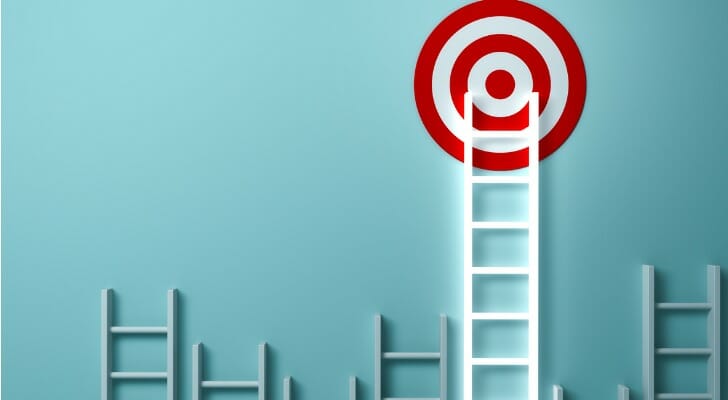Certificates of deposit, or CDs, come in various term lengths. Once you make your initial deposit, you cannot access the money in the account until the end of the account’s term, also known as its maturity date. A CD ladder means you’re socking money away in CDs of various maturity dates at the same time. This structure prevents you from dipping into your savings unnecessarily but also allows you more access to your cash at different intervals. To utilize this or other investment strategies, consider working with a financial advisor.
How to Get Started Building a CD Ladder
If you’re looking to build a CD ladder, chances are you already know what it is. To brush up, a CD ladder is when you open multiple CD accounts at the same time, each with a different maturity date. This allows you to create a source of income that remains steady over the years.
To calculate how much interest you could earn with a CD, try using SmartAsset’s CD calculator.
You can create your CD ladder in whichever way best fits your financial situation and goals. If you have more short-term savings goals, you can set up your ladder with maturity dates every few months. By contrast, if you want to benefit from payouts every year or so instead, you can set up your ladder to mature over a few years.
For example, you could open a one-year, a three-year and a five-year CD to expect a payout at the end of each term. Plus, at the end of both the three- and five-year accounts, you can benefit from the one-year account as well if you choose to keep it open throughout the years.
It also helps immensely to create your CD ladder with the best CD rates you can find. That can really boost your savings over time and make setting aside large sums of money more worthwhile.
Who Offers the Best CD Ladders

Usually, creating a CD ladder involves you picking your bank and choosing the various terms to open all on your own. However, the online bank Citizens Access offers a CD Ladder account option to make the process much easier for you. Its CD ladder calculator can help you figure out how to split up your total initial investment amount depending on how far you want to stretch your ladder. Then when it comes time to create your ladder, simply clicking an “open account” button will take you to the first step where you can easily open multiple accounts in one go. Citizens Access CDs do require at least $5,000 to open one.
Since $5,000 is a high minimum to meet for one account, let alone multiple accounts, you might want to check out Ally Bank’s High Yield CDs and Capital One’s CDs. Along with the banks’ high-earning interest rates, neither Ally Bank nor Capital One requires a minimum deposit for its certificates of deposit. That way, you can open a CD, or multiple CDs, with any amounts you might have available. This can make it much easier to afford a CD ladder without thousands of dollars. You will have to open each CD in your ladder individually, however, unlike the ease that Citizens Access offers.
If you want better rates on longer-term savings, then you can turn to Marcus by Goldman Sachs. You can choose from nine Marcus CDs, each with a highly competitive interest rate. The best rates are reserved for terms of one year and longer with the highest rate clocking in at 3.90% for the six-year term.
Should I Build a CD Ladder?
An important part to note about CD ladders is that you have to meet the minimum deposit requirement for each account you open. Banks typically require a minimum deposit of $500 or higher to open a CD account. Some minimum requirements can reach as high as $10,000 while other banks don’t require a minimum at all. It’s important to double-check these minimums with your potential CD ladder bank and to ensure you can safely afford to meet the minimum multiple times.
Once you’ve determined that you can meet the minimum deposit a few times over, you should definitely consider building a CD ladder. It’s a great way to build solid savings over time, especially for those of us who tend to dip into our savings too regularly. Not only does it keep your savings safe and in check, but it also provides a steady stream of money over the months and years.
If you can’t meet the minimums required at your chosen bank, don’t forget to take a look at banks like Ally and Capital One. You’ll have to be comfortable with online banking, but the savings you can benefit from are great enough to consider opening your CD ladder with one of those banks.
The Bottom Line

Certificates of deposit are great ways to save your money safely and responsibly. Opening multiple CDs to build a CD ladder allows you to stretch your savings over time, meeting both short- and long-term savings goals. Typically, you have to open each account separately, but if you’re able to meet Citizens Access’ high minimum, you can take advantage of its CD ladder product. Make sure you compare CD rates across multiple financial institutions.
Tips for Banking Responsibly
- If you need help really maximizing your money’s potential, consider working with a financial advisor. The right advisor can look at your finances comprehensively, determining where to cut costs and where you can invest better. Finding a financial advisor doesn’t have to be hard. SmartAsset’s free tool matches you with up to three vetted financial advisors who serve your area, and you can interview your advisor matches at no cost to decide which one is right for you. If you’re ready to find an advisor who can help you achieve your financial goals, get started now.
- Sometimes it’s not enough just to open bank accounts, fund them and leave them to their own devices. That can lead to unnecessary fees and wasted savings potential. It’s important to bank actively and responsibly. For starters, you should check whether your checking account charges a monthly fee for simply owning the account. If it does, see if you can meet certain qualifications to waive that fee. There are also a number of free checking accounts that you can choose from in order to avoid losing money to a pesky fee like that.
- Another way to optimize your money and bank accounts is to place your money in high-earning accounts. For one, you don’t want most of your money unused in a non-interest-earning checking account. Moving what you won’t spend into an interest-earning checking account or a high-yield savings account will put your money to much better use.
Photo credit: ©iStock.com/lovelyday12, ©iStock.com/masterzphotois, ©iStock.com/RichVintage
